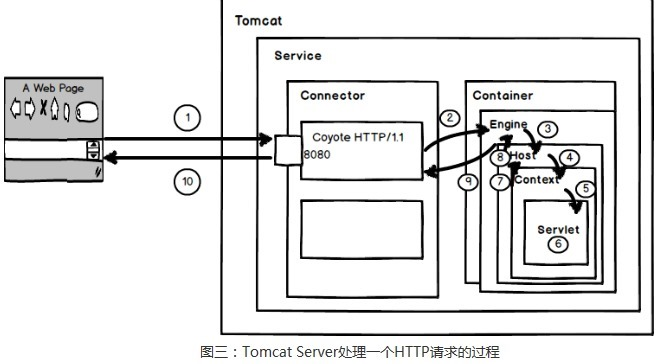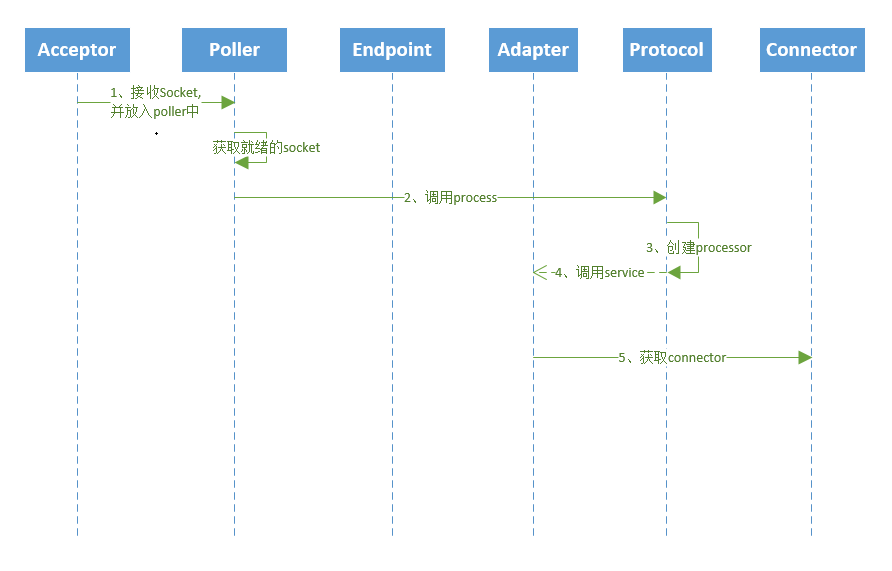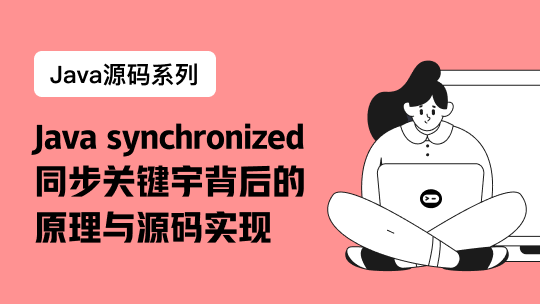先上一个图:
从图上我们可以了解到跟一个请求相关的组件大概有 connector、coyote、engine、host、context、servlet
那么会有几个问题:
1、connector是如何监听和接收请求的
2、connector如何传递请求到engine
3、engine又是如何经过一步一步的传递到servlet中
4、servlet又是如何传递到我们自己写的servlet中
1、connector如何接收请求
a、从tomcat初始化和启动,可以看出connector会反射初始化一个protocolHandler,
1 public Connector(String protocol) {
2 setProtocol(protocol);
3 // Instantiate protocol handler
4 ProtocolHandler p = null;
5 try {
6 Class<?> clazz = Class.forName(protocolHandlerClassName);
7 p = (ProtocolHandler) clazz.getConstructor().newInstance();
8 } catch (Exception e) {
9 log.error(sm.getString(
10 "coyoteConnector.protocolHandlerInstantiationFailed"), e);
11 } finally {
12 this.protocolHandler = p;
13 }
14
15 if (Globals.STRICT_SERVLET_COMPLIANCE) {
16 uriCharset = StandardCharsets.ISO_8859_1;
17 } else {
18 uriCharset = StandardCharsets.UTF_8;
19 }
20 }
在初始化connector的时候也会初始化protocolHandler的adapter
// Initialize adapter
adapter = new CoyoteAdapter(this);
protocolHandler.setAdapter(adapter);
protocolHandler我们一般会在server.xml中配置 org.apache.coyote.http11.Http11NioProtocol ,如果不配置默认也是NioProtocol(tomcat8中)
/**
* Coyote Protocol handler class name.
* Defaults to the Coyote HTTP/1.1 protocolHandler.
*/
protected String protocolHandlerClassName = "org.apache.coyote.http11.Http11NioProtocol";
b、protocol 在初始化的时候又会初始化endpoint
public class Http11NioProtocol extends AbstractHttp11JsseProtocol<NioChannel> {
private static final Log log = LogFactory.getLog(Http11NioProtocol.class);
public Http11NioProtocol() {
super(new NioEndpoint());
}
最终会调用父类的构造方法,有设置默认连接超时时间为60000毫秒,并且初始化一个ConnectionHandler,这个类就是请求处理的入口。
public AbstractHttp11Protocol(AbstractEndpoint<S> endpoint) {
super(endpoint);
setConnectionTimeout(Constants.DEFAULT_CONNECTION_TIMEOUT);
ConnectionHandler<S> cHandler = new ConnectionHandler<>(this);
setHandler(cHandler);
getEndpoint().setHandler(cHandler);
}
public static final int DEFAULT_CONNECTION_TIMEOUT = 60000;
c、上面找到了请求入口,那么下面我们看一下如何接收的(endpoint)
在初始化和启动protocol的时候会一起初始化和启动endpoint,在endpoint中会启动一批poller线程和acceptor线程
/**
* Start the NIO endpoint, creating acceptor, poller threads.
*/
@Override
public void startInternal() throws Exception {
.......
// Start poller threads
pollers = new Poller[getPollerThreadCount()];
for (int i=0; i<pollers.length; i++) {
pollers[i] = new Poller();
Thread pollerThread = new Thread(pollers[i], getName() + "-ClientPoller-"+i);
pollerThread.setPriority(threadPriority);
pollerThread.setDaemon(true);
pollerThread.start();
}
startAcceptorThreads();
}
}
protected final void startAcceptorThreads() {
int count = getAcceptorThreadCount();
acceptors = new Acceptor[count];
for (int i = 0; i < count; i++) {
acceptors[i] = createAcceptor();
String threadName = getName() + "-Acceptor-" + i;
acceptors[i].setThreadName(threadName);
Thread t = new Thread(acceptors[i], threadName);
t.setPriority(getAcceptorThreadPriority());
t.setDaemon(getDaemon());
t.start();
}
}
下面看一下Acceptor的Nio实现:
/**
* The background thread that listens for incoming TCP/IP connections and
* hands them off to an appropriate processor.
*/
protected class Acceptor extends AbstractEndpoint.Acceptor {
@Override
public void run() {
int errorDelay = 0;
// Loop until we receive a shutdown command
while (running) {
// Loop if endpoint is paused
while (paused && running) {
state = AcceptorState.PAUSED;
try {
Thread.sleep(50);
} catch (InterruptedException e) {
// Ignore
}
}
if (!running) {
break;
}
state = AcceptorState.RUNNING;
try {
//if we have reached max connections, wait
countUpOrAwaitConnection();
SocketChannel socket = null;
try {
// Accept the next incoming connection from the server
// socket
socket = serverSock.accept();
} catch (IOException ioe) {
// We didn't get a socket
countDownConnection();
if (running) {
// Introduce delay if necessary
errorDelay = handleExceptionWithDelay(errorDelay);
// re-throw
throw ioe;
} else {
break;
}
}
// Successful accept, reset the error delay
errorDelay = 0;
// Configure the socket
if (running && !paused) {
// setSocketOptions() will hand the socket off to
// an appropriate processor if successful
if (!setSocketOptions(socket)) {
closeSocket(socket);
}
} else {
closeSocket(socket);
}
} catch (Throwable t) {
ExceptionUtils.handleThrowable(t);
log.error(sm.getString("endpoint.accept.fail"), t);
}
}
state = AcceptorState.ENDED;
}
上面可以看见主要做的事就是接收一个socket连接,然后调用setSocketOptions()
protected boolean setSocketOptions(SocketChannel socket) {
// Process the connection
try {
//disable blocking, APR style, we are gonna be polling it
socket.configureBlocking(false);
Socket sock = socket.socket();
socketProperties.setProperties(sock);
NioChannel channel = nioChannels.pop();
if (channel == null) {
SocketBufferHandler bufhandler = new SocketBufferHandler(
socketProperties.getAppReadBufSize(),
socketProperties.getAppWriteBufSize(),
socketProperties.getDirectBuffer());
if (isSSLEnabled()) {
channel = new SecureNioChannel(socket, bufhandler, selectorPool, this);
} else {
channel = new NioChannel(socket, bufhandler);
}
} else {
channel.setIOChannel(socket);
channel.reset();
}
getPoller0().register(channel);
} catch (Throwable t) {
ExceptionUtils.handleThrowable(t);
try {
log.error("",t);
} catch (Throwable tt) {
ExceptionUtils.handleThrowable(tt);
}
// Tell to close the socket
return false;
}
return true;
}
在setSocketOptions中,会将socket的channel放入poller中处理。
/**
* Registers a newly created socket with the poller.
*
* @param socket The newly created socket
*/
public void register(final NioChannel socket) {
socket.setPoller(this);
NioSocketWrapper ka = new NioSocketWrapper(socket, NioEndpoint.this);
socket.setSocketWrapper(ka);
ka.setPoller(this);
ka.setReadTimeout(getSocketProperties().getSoTimeout());
ka.setWriteTimeout(getSocketProperties().getSoTimeout());
ka.setKeepAliveLeft(NioEndpoint.this.getMaxKeepAliveRequests());
ka.setSecure(isSSLEnabled());
ka.setReadTimeout(getConnectionTimeout());
ka.setWriteTimeout(getConnectionTimeout());
PollerEvent r = eventCache.pop();
ka.interestOps(SelectionKey.OP_READ);//this is what OP_REGISTER turns into.
if ( r==null) r = new PollerEvent(socket,ka,OP_REGISTER);
else r.reset(socket,ka,OP_REGISTER);
addEvent(r);
}
注册channel事件的时候,先将channel包装成一个socketWrapper然后放入poller中,
Nio的poller大概实现的功能包括:请求事件注册(上面方法),获取请求就绪的socket,处理就绪的socket
1)请求注册到select上面,获取事件,调用run()方法来注册socket
/**
* Processes events in the event queue of the Poller.
*
* @return <code>true</code> if some events were processed,
* <code>false</code> if queue was empty
*/
public boolean events() {
boolean result = false;
PollerEvent pe = null;
for (int i = 0, size = events.size(); i < size && (pe = events.poll()) != null; i++ ) {
result = true;
try {
pe.run();
pe.reset();
if (running && !paused) {
eventCache.push(pe);
}
} catch ( Throwable x ) {
log.error("",x);
}
}
return result;
}
event的run方法会将socket时间注入到select上
if (interestOps == OP_REGISTER) {
try {
socket.getIOChannel().register(
socket.getPoller().getSelector(), SelectionKey.OP_READ, socketWrapper);
} catch (Exception x) {
log.error(sm.getString("endpoint.nio.registerFail"), x);
}
} else {
final SelectionKey key = socket.getIOChannel().keyFor(socket.getPoller().getSelector());
2)poller注册了socket事件,当事件就绪后,poller会获取就绪的socket
Iterator<SelectionKey> iterator =
keyCount > 0 ? selector.selectedKeys().iterator() : null;
// Walk through the collection of ready keys and dispatch
// any active event.
while (iterator != null && iterator.hasNext()) {
SelectionKey sk = iterator.next();
NioSocketWrapper attachment = (NioSocketWrapper)sk.attachment();
// Attachment may be null if another thread has called
// cancelledKey()
if (attachment == null) {
iterator.remove();
} else {
iterator.remove();
processKey(sk, attachment);
}
}//while
processKey主要会做3件事: 处理sendFile(后面讲)、处理socket、关闭socket
if ( attachment.getSendfileData() != null ) {
processSendfile(sk,attachment, false);
} else {
unreg(sk, attachment, sk.readyOps());
boolean closeSocket = false;
// Read goes before write
if (sk.isReadable()) {
if (!processSocket(attachment, SocketEvent.OPEN_READ, true)) {
closeSocket = true;
}
}
3)处理socket事件
SocketState state = SocketState.OPEN;
// Process the request from this socket
if (event == null) {
state = getHandler().process(socketWrapper, SocketEvent.OPEN_READ);
} else {
state = getHandler().process(socketWrapper, event);
}
handler极为最初connector初始化的Http11NioProtocol ,process()方法会创建一个processor,并调用processor的process()方法
if (processor == null) {
processor = getProtocol().createProcessor();
register(processor);
}
processor.setSslSupport(
wrapper.getSslSupport(getProtocol().getClientCertProvider()));
// Associate the processor with the connection
connections.put(socket, processor);
SocketState state = SocketState.CLOSED;
do {
state = processor.process(wrapper, status);
getProtocol().createProcessor()创建的是Http11Processor对象,主要功能是process,service,dispatch,dispatch暂时不讲,process会调用service方法来处理请求。
} else if (isAsync() || isUpgrade() || state == SocketState.ASYNC_END) {
state = dispatch(status);
if (state == SocketState.OPEN) {
// There may be pipe-lined data to read. If the data isn't
// processed now, execution will exit this loop and call
// release() which will recycle the processor (and input
// buffer) deleting any pipe-lined data. To avoid this,
// process it now.
state = service(socketWrapper);
}
service 方法又会调用adapter的service方法
// Process the request in the adapter
if (!getErrorState().isError()) {
try {
rp.setStage(org.apache.coyote.Constants.STAGE_SERVICE);
getAdapter().service(request, response);
终上所述,我们已经走到Adapter(CoyoteAdapter)的service方法了,也就是最上面的图的第一步已经走完了。那么请求又是如何从adapter传递到Engine的呢。
//check valves if we support async
request.setAsyncSupported(
connector.getService().getContainer().getPipeline().isAsyncSupported());
// Calling the container
connector.getService().getContainer().getPipeline().getFirst().invoke(
request, response);
3、connector.getService()获取到的就是standardService, getContainer()获取到的就是standardEngine
standardEngine的pipeline就是StandardPipeline,getFirst()会调用StandardEngine的StandardEngineValve对象的invoke()
@Override
public final void invoke(Request request, Response response)
throws IOException, ServletException {
// Select the Host to be used for this Request
Host host = request.getHost();
if (host == null) {
response.sendError
(HttpServletResponse.SC_BAD_REQUEST,
sm.getString("standardEngine.noHost",
request.getServerName()));
return;
}
if (request.isAsyncSupported()) {
request.setAsyncSupported(host.getPipeline().isAsyncSupported());
}
// Ask this Host to process this request
host.getPipeline().getFirst().invoke(request, response);
}
请求就在进入engine的管道后,就开始了请求链的处理。
找到host(StandardHost)的pipeline/valve。
host找到context(StandardConext)的pipeline/valve。
4、context找到wrapper(StandardWrapper)的pileline/valve,wrapper的valve就是最接近servlet处理的地方了,它会分配一个servlet并创建一个过滤器链
// Allocate a servlet instance to process this request
try {
if (!unavailable) {
servlet = wrapper.allocate();
}
} catch (UnavailableException e) {
public Servlet allocate() throws ServletException {boolean newInstance = false;
// If not SingleThreadedModel, return the same instance every time
if (!singleThreadModel) {
// Load and initialize our instance if necessary
if (instance == null || !instanceInitialized) {
synchronized (this) {
if (instance == null) {
try {
// Note: We don't know if the Servlet implements
// SingleThreadModel until we have loaded it.
instance = loadServlet();
newInstance = true;
public synchronized Servlet loadServlet() throws ServletException {
// Nothing to do if we already have an instance or an instance pool
if (!singleThreadModel && (instance != null))
return instance;
Servlet servlet;
try {
InstanceManager instanceManager = ((StandardContext)getParent()).getInstanceManager();
try {
servlet = (Servlet) instanceManager.newInstance(servletClass);
} catch (ClassCastException e) {
创建过滤器链
// Create the filter chain for this request
ApplicationFilterChain filterChain =
ApplicationFilterFactory.createFilterChain(request, wrapper, servlet);
关于servlet如何加载的在讲tomcat初始化的时候有提到,在StandardContext的时候会读取web.xml配置文件加载application,
具体实现在ContextConfig的configureStart()中会调用webConfig(),最终会调用configureContext加载配置的servlet
for (ServletDef servlet : webxml.getServlets().values()) {
Wrapper wrapper = context.createWrapper();
// Description is ignored
// Display name is ignored
// Icons are ignored
// jsp-file gets passed to the JSP Servlet as an init-param
if (servlet.getLoadOnStartup() != null) {
wrapper.setLoadOnStartup(servlet.getLoadOnStartup().intValue());
}
if (servlet.getEnabled() != null) {
wrapper.setEnabled(servlet.getEnabled().booleanValue());
}
wrapper.setName(servlet.getServletName());
Map<String,String> params = servlet.getParameterMap();
for (Entry<String, String> entry : params.entrySet()) {
wrapper.addInitParameter(entry.getKey(), entry.getValue());
}
wrapper.setRunAs(servlet.getRunAs());
Set<SecurityRoleRef> roleRefs = servlet.getSecurityRoleRefs();
for (SecurityRoleRef roleRef : roleRefs) {
wrapper.addSecurityReference(
roleRef.getName(), roleRef.getLink());
}
wrapper.setServletClass(servlet.getServletClass());
到此就进入了应用的servlet了。具体的servlet如何处理request,然后如何返回response,tomcat如何处理response就不再此讲述了。
附图:
A、接收请求

B、传递请求到servlet















